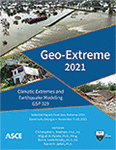Ground Motions Associated with 2011 Mineral, Virginia, Earthquake
Publication: Geo-Extreme 2021
ABSTRACT
The 2011 Mineral, Virginia, Earthquake impacted a large area of the central and eastern United States (CEUS). This paper estimates the ground-motion intensity in northeast Pennsylvania with an epicentral distance of 384 km using existing ground-motion attenuation models. The corrected ground-motion data from the Pacific Earthquake Engineering Research Center (PEER) is used to estimate the ground motion in northeast Pennsylvania for comparison with available attenuation models. The attenuation models were also compared with US Geological Survey (USGS) “Did You Feel It?” intensity reports. The estimated rock site peak horizontal ground acceleration in northeast Pennsylvania is between 0.0075 and 0.030g.
Get full access to this article
View all available purchase options and get full access to this chapter.
REFERENCES
Ancheta, T. D., Darragh, R. B., Stewart, J. P., Seyhan, E., Silva, W. J., Chiou, B. S. J., Wooddell, K. E., Graves, R. W., Kottke, A. R., Boore, D. M., Kishida, T., and Donahue, J. L. (2020). PEER NGAWest2 database, Earthq. Spectra 30, 989–1006.
Atkinson, G. M. (2015). “Ground-motion prediction equation for small to moderate events at short hypocentral distances, with application to induced seismicity hazards.” Bull. Seismol. Soc. Am. 105, no. 2A, 981–992.
Atkinson, G. M., and Boore, D. M. (2006). “Ground motion prediction equations for earthquakes in eastern North America.” Bull. Seismol. Soc. Am. 96, 2181–2205.
Atkinson, G. M., and Kaka, S. I. (2007). “Relationships between Felt Intensity and Instrumental Ground Motion in Central U.S. and California.” Bull. Seismol. Soc. Am. 97, 497–510.
Boore, D. M, Alessandro, C. D., and Abrahamson, N. A. (2014). “A Generalization of the Double-Corner-Frequency Source Spectral Model and Its Use in the SCEC BBP Validation Exercise.” Bull. Seismol. Soc. Am. 104(5), 2387–2398.
Bozorgnia, Y., and Bertero, V. (2004). Earthquake Engineering. Boca Raton: CRC Press, https://doi.org/10.1201/9780203486245.
Campbell, K. W. (2003). “Prediction of strong ground motion using the hybrid empirical method and its use in the development of ground–motion (attenuation) relations in eastern North America.” Bull. Seismol. Soc. Am. 93, 1012–1033.
Ellsworth, W. L., Imanishi, K., and Luetgert, J. H. (2012). “Mw 5.8 Virginia earthquake of August 23, 2011: High stress drop in critically stressed crust.” Seismol. Res. Lett. 83(1), 212–213.
Gupta, A., Baker, J. W., and Ellsworth, W. L. (2017). “Assessing groundmotion amplitudes and attenuation for small-to-moderate induced and tectonic earthquakes in the central and eastern United States.” Seismol. Res. Lett. 88, 1379–1389.
International Code Council. (2000). International building code. Falls Church, Va. :International Code Council. https://shop.iccsafe.org/2000-international-building-coder-pdf-download.html.
Hough, S. E. (2012). “Initial Assessment of the Intensity Distribution of the 2011Mw 5.8 Mineral, Virginia, Earthquake”. Seismol. Res. Lett. 83(5), 649–657.
Jibson, R. W., and Harp, E. L. (2012). “Extraordinary Distance Limits of Landslide Triggered by the 2011 Mineral, Virginia Earthquake.” Bull. Seismol. Soc. Am., 102(6), 1–10.
Kramer, S. L. (1996). Geotechnical Earthquake Engineering, New Jersey, Prentice Hall.
Seyhan, E., and Stewart, J. P. (2014). “Semi-empirical nonlinear site amplification from NGA-West2 data and simulations”, Earthq. Spectra, 30, no. 3, 1241–1256.
Shahjouei, A., and Pezeshk, S. (2016). “Alternative hybrid empirical ground-motion model for central and eastern North America using hybrid simulations and NGA-West2 models.” Bull. Seismol. Soc. Am. 106(2), 734–754.
Silva, W., Gregor, N., and Darragh, R. (2002). Development of regional hard rock attenuation relationships for central and eastern North America. Pacific Engineering and Analysis, 311 Pomona Ave., El Cerrito, CA 94530.
Tackett, D. (2014). Pike County Emergency Management, written communication.
Toro, G., Abrahamson, N. A., and Schneider, J. F. (1997). “Model of Strong Ground Motions from Earthquakes in Central and Eastern North America: Best Estimates and uncertainties. “Seismol. Res. Lett. 68(1), 41–57.
Soil Survey Staff, Natural Resources Conservation Service, United States Department of Agriculture. (2020). “Web Soil Survey”. Available online at the following link: http://websoilsurvey.sc.egov.usda.gov/. Accessed [10/22/2020].
USGS. (2020). “On August 23, 2011 tens of millions of people along the East Coast suddenly felt the earth shaking from the largest earthquake in the eastern U.S. since the M5.8 earthquake in 1944 near Cornwall and Massena, New York.” https://www.usgs.gov/natural-hazards/earthquake-hazards/science/m58-august-23-2011-mineral-virginia?qt-science_center_objects=0#qt-science_center_objects.
Information & Authors
Information
Published In
Copyright
© 2021 American Society of Civil Engineers.
History
Published online: Nov 4, 2021
Authors
Metrics & Citations
Metrics
Citations
Download citation
If you have the appropriate software installed, you can download article citation data to the citation manager of your choice. Simply select your manager software from the list below and click Download.
